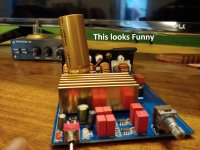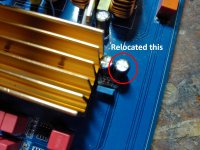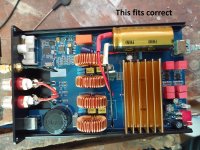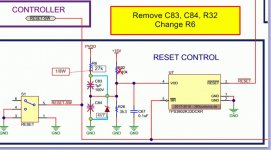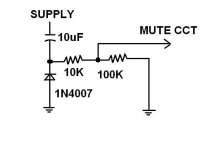Hello everyone,
I bought a tpa3255 board from 3e-audio .
I have to buy the power supply.
can anyone tell me what is the absorption peak of this amp?
p.s .: some of my friends have measured, on a tpa 3116, a peak of about 10A. Why does the 3eaudio power supply stop at 400W 8.5A?
I bought a tpa3255 board from 3e-audio .
I have to buy the power supply.
can anyone tell me what is the absorption peak of this amp?
p.s .: some of my friends have measured, on a tpa 3116, a peak of about 10A. Why does the 3eaudio power supply stop at 400W 8.5A?
Hi Zenit70
The TPA3116 is rated at max 26V- better 24V...so the power is limited by this voltage and the impdeance of your speakers.
the TPA3255 is rated up to 53,5V operating voltage. according to the datasheet you get for stereo --> 1%THD for 4R load 260Watt per channel !
so it could be that a 400W power supply is sufficient 😀😉
i personally use 36V- 350Watt smps 9,7A ......(48V / 7,6A). so if you use 8R speakers you "need" more voltage for the rails (smps) to get more power.
P = U^2/R
chris
The TPA3116 is rated at max 26V- better 24V...so the power is limited by this voltage and the impdeance of your speakers.
the TPA3255 is rated up to 53,5V operating voltage. according to the datasheet you get for stereo --> 1%THD for 4R load 260Watt per channel !
so it could be that a 400W power supply is sufficient 😀😉
i personally use 36V- 350Watt smps 9,7A ......(48V / 7,6A). so if you use 8R speakers you "need" more voltage for the rails (smps) to get more power.
P = U^2/R
chris
Last edited:
thanks for the clarifications
I was wondering, given the fact that our speakers can go down to 2 ohms, why not take this power with doubled capacities compared to the 3eaudio board.
what would you take if you were in my place?
800W DC48V LLC Switching power supply board for amplifier PSU TPA3255 amp etc | eBay
I was wondering, given the fact that our speakers can go down to 2 ohms, why not take this power with doubled capacities compared to the 3eaudio board.
what would you take if you were in my place?
800W DC48V LLC Switching power supply board for amplifier PSU TPA3255 amp etc | eBay
thanks for the clarifications
I was wondering, given the fact that our speakers can go down to 2 ohms, why not take this power with doubled capacities compared to the 3eaudio board.
what would you take if you were in my place?
800W DC48V LLC Switching power supply board for amplifier PSU TPA3255 amp etc | eBay
Hi
i am not the SMPS experts. I use for home use the LRS 350-36 psu and during listening i did some measuremnts at home(26m^2 listening room) i got at very loud session about 60-100W peak. so no need for much power. for bigger rooms, or outdoor, boombox you might need more. a THD of 10% at low frequencies is not as bad (short) so a lot of other boards/amps can deliver much power for outdoor use.
a very good explanation by our friend FF:...please read...
https://www.diyaudio.com/forums/class-d/104822-favorite-threads-posts-class-forum-2.html#post5683013
chris
Last edited:
very valuable reading,Hi
i am not the SMPS experts. I use for home use the LRS 350-36 psu and during listening i did some measuremnts at home(26m^2 listening room) i got at very loud session about 60-100W peak. so no need for much power. for bigger rooms, or outdoor, boombox you might need more. a THD of 10% at low frequencies is not as bad (short) so a lot of other boards/amps can deliver much power for outdoor use.
a very good explanation by our friend FF:...please read...
https://www.diyaudio.com/forums/class-d/104822-favorite-threads-posts-class-forum-2.html#post5683013
chris
I thank you for the clarity and completeness of the message
very valuable reading,
I thank you for the clarity and completeness of the message
prego
your welcome
got a few caps 4700uf. none fits. space too tight.yes- the low esr/esl cap is at class D very important. you have to find a size which fits here and as big as possible but low esr/esl
will leave it like that for now. case mod if reqd once i run in this thing for some more time.
thankyou
got a few caps 4700uf. none fits. space too tight.
will leave it like that for now. case mod if reqd once i run in this thing for some more time.
thankyou
yep to find the correct size with the lowest ESR/ESL is not as easy. especially if you have less space available 😀
https://www.diyaudio.com/forums/class-d/309813-wrong-tpa3255-77.html#post5701127
chris
replaced the original 68uf nichicon capacitor that came with the amplifier with a 4700uf 63v Nichicon muse. this is the best i could procure. relocated a cap and gave the cap extra long legs. and hot glued in place.
The sound output has indeed improved. the bass sound less muddy. overall output is good
The sound output has indeed improved. the bass sound less muddy. overall output is good
Attachments
My amp now starts well, plays good for few minutes and then the sound slowly drops till you can hardly hear. some times it increases again and falls or some times remain ultra low voulme.
switching on and restart immediately has no effect. but switch off for 5 minutes and restart sound at normal volume and then again it slowly fades.
what may be the reason for this?? tried on multiple input source both bluetooth and dac/preamp.
running on 32v dc powersupply checked it and has steady output
switching on and restart immediately has no effect. but switch off for 5 minutes and restart sound at normal volume and then again it slowly fades.
what may be the reason for this?? tried on multiple input source both bluetooth and dac/preamp.
running on 32v dc powersupply checked it and has steady output
Last edited:
I often read about D-amps having problems with Bi-amping loudspeakers.
This is a logical result on many designs!
The midd/ high part of a bi-amped speaker is a "no-load" situation for the lower frequency.
So if the amp does not like beeing driven with open output, it may fail or produce all kinds of problems, like overheating or sudden shut down, some even burn the chips internals.
So, first check the amps capabilities, then connect!
The "right way" of bi-amping is a two way active configuration, that eliminates the passive x-over. Often these two completely different topics get thrown into one bowl.
This is a logical result on many designs!
The midd/ high part of a bi-amped speaker is a "no-load" situation for the lower frequency.
So if the amp does not like beeing driven with open output, it may fail or produce all kinds of problems, like overheating or sudden shut down, some even burn the chips internals.
So, first check the amps capabilities, then connect!
The "right way" of bi-amping is a two way active configuration, that eliminates the passive x-over. Often these two completely different topics get thrown into one bowl.
@KCN
check the mute pin of your amp, it might charge up and enable itself after some time. Read the data sheet and compare your specific implementation. Maybe some safety feature engages?
check the mute pin of your amp, it might charge up and enable itself after some time. Read the data sheet and compare your specific implementation. Maybe some safety feature engages?
Hi, Mate. What do you mean check the mute pin? What status/ voltage it should be and how to reset it?
Hi anatoliy
i guess turbowatch is mentioned a circuit to avoid a faster power up of the TPA chip. i mean : if you switch on the amp board the rail voltage starts to rise and the tpa chip wants to "switch on" and therefore you will here this pop on sound.
to avoid this there is a circuit at the mute pin to "hold" the tpa chip "mute" = quiet.
at the YJ tpa3255 board there is a voltage superviser chip on board to do that.
-->TPS3802...please read some posts...its not so easy😀
https://www.diyaudio.com/forums/class-d/309813-wrong-tpa3255-75.html#post5687215
doctor created this circuit....
this mute circuit can be done with some RC divider too..pic 2
chris
i guess turbowatch is mentioned a circuit to avoid a faster power up of the TPA chip. i mean : if you switch on the amp board the rail voltage starts to rise and the tpa chip wants to "switch on" and therefore you will here this pop on sound.
to avoid this there is a circuit at the mute pin to "hold" the tpa chip "mute" = quiet.
at the YJ tpa3255 board there is a voltage superviser chip on board to do that.
-->TPS3802...please read some posts...its not so easy😀
https://www.diyaudio.com/forums/class-d/309813-wrong-tpa3255-75.html#post5687215
doctor created this circuit....
this mute circuit can be done with some RC divider too..pic 2
chris
Attachments
Last edited:
......
The midd/ high part of a bi-amped speaker is a "no-load" situation for the lower frequency.
.
hi turbowatch2
can you explain this:
The midd/ high part of a bi-amped speaker is a "no-load" situation for the lower frequency.
chris
this mute circuit can be done with some RC divider too..pic 2
The second circuit doesnt make sense here and will fry the TPA inputs due to overvoltage.
The second circuit doesnt make sense here and will fry the TPA inputs due to overvoltage.
yes you are right...its bad to show the principle of the circuit with wrong values....
sorry
It is not showing the principle of the circuit, it behaves completely different. (As it is totaly different)
My speakers are not bi-amped. No mute pin in schematics.
i have changed the caps that i had put in earlier, even put lower value caps but same result.
the music plays normally and then reduces in volume. it is not complete mute. some times the voulme ebbs and dies but the sound is there at very low volume.
The large input cap near the dc jack? will and problem in that cause such result, as if the amp input current is fluctuating?
any input/help welcome.
i have changed the caps that i had put in earlier, even put lower value caps but same result.
the music plays normally and then reduces in volume. it is not complete mute. some times the voulme ebbs and dies but the sound is there at very low volume.
The large input cap near the dc jack? will and problem in that cause such result, as if the amp input current is fluctuating?
any input/help welcome.
- Home
- Amplifiers
- Class D
- TPA3255 - all about DIY, Discussion, Design etc
